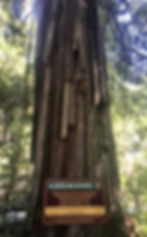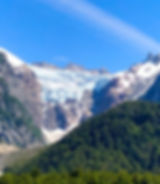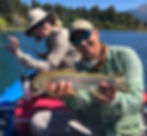In the starting blocks after another delightful practice-trip to Patagonia
- Martijn
- Feb 27, 2021
- 5 min read
After having postponed our trip by about a month, we are in the starting blocks for a somewhat re-engineered round the world flight. We are thinking we might actually leave this coming week! You might have noticed that the picture on this website has changed, we are also planning to add a link to our live tracker and to a Youtube channel where you will be able to see our Go-Pro videos (thanks to Carmen for the technical help).
Our new site picture:

What's our new plan? In order to reduce our exposure to new variants of the virus and the number of countries we cross - which all have their own regulations and testing/quarantine requirements -, we are planning to ferry though Brazil and the Caribbean to reach our first goal: the USA where we will have the plane checked, take care of our Green card renewal and hopefully get a Covid vaccine, although we might be too young to get it in time... (the priority group in the US is 65 years and over). After that, we are planning to cross-over to Europe via Greenland and instead of going through Middle-East/India/South East Asia and Japan, we now prefer crossing Russia from West to East - from St Petersburg to Kamchatka- before crossing the Behring strait to Alaska. The time span is therefore also reduced: we need to do the intercontinental crossings between May 15th and September 15th. If for some reason we can not exit Russia between those dates, we will stay in Europe and finish the tour some other time. So glad we have been practicing flexibility!
Speaking of flexibility, we are somewhat homeless since the beginning of February: our house is sold (new owners take possession on April 1st) and, since we were not planning to be in Buenos Aires in February, Alex' niece moved in with her family to stay until the end of March. This means that Alex and I are now based in the guest room in the back of the garden, just like we will often be when we rent Airbnb accommodations during our trip, so we take it as another good practice for our 2021 life.
Working on our plan at breakfast in the back of the garden

We were so ready to go in February and so frustrated, so we decided to start our trip anyway and traveled to the Patagonian pre-Andes mountains in the South of Argentina. First we went to a town called Trevelin that was originally created by welsh settlers (Trevelin apparently means "village of the mill") where there is a flying school called Patagonia Bush pilots that gives mountain flying courses. Alex had always wanted to do such a training and it was a great success: we learned the theory behind the movement of the wind in the mountains, updrafts and downdrafts, both potentially dangerous, about leeward and windward, and after that could practice first in the school's plane and then in our own. I am very proud of my first mountain flight with instructor Queque Parodi. My flight was very calm and far from the terrain, and the highlight was a 180 turn to be able to judge the distance required to turn around in a valley or a canyon in order never to get stuck!
Alex of course, when it was his turn, did much more difficult things which make me feel very safe on board with him. In any case, we are now officially Patagonia Bush pilots :)

We also did some sightseeing on the ground around Trevelin. The surroundings are beautiful: mountains and lakes everywhere and a National Park with millennial trees called alerces. Their scientific name, Fitzroya cupressoides, was given by Charles Darwin as a tribute to Robert FitzRoy, the captain of the ship Beagle he was touring the world on, between 1831 and 1836. According to the ranger who guided us, these are the second oldest trees in the world after the Bristlecone pine (Pinus longaeva) and before the famous Sequoia.


The views of the Andes are amazing in the park and the dimensions are humbling.

It has over 10 lakes, including Lake Futalaufken (44km2), Lake Menendez (55km2) and this is just one of many national parks in Argentina. As another example of proportions, the well-known wetlands "Esteros del Iberá" in the Northern province of Corrientes are as big as 30% of the whole Netherlands!
In the same park, there are mountain streams with waterholes (called pozones) with beautifully clear and cool water.

Due to the many paths the water takes when the snow melts, some streams have traveled longer than others and are warmer. It is such a little stream, running under a pile of snow that caused the ice tunnel on the pictures below. Each year it almost closes in the winter and starts melting again in the spring (you can see the drops). Somewhere towards the end of February, it opens completely, letting through all the daylight. When we were there, it was about 70% open and we could see the light waiting to get in.



The province this national park and the Welsh town are in is called Chubut. By chatting with the locals, we understood that around all this natural beauty was a poorly managed province that didn't pay its teachers and other civil servants on time, did not maintain roads and made it quite difficult for anyone who wanted to develop a business. The bright side is that all this natural beauty will likely stay unspoiled for a while. That is much better for the trouts also! Of course we put ours back in the water but they are probably better off if there are not too many fly fishers. Even if Alex and I can hardly be called fly fishers: we took our first lesson right there and the guide did most of the work, at least for me because when I finally caught a fish I had no idea what to do with it and absolutely did not want to touch it. Alex was much braver.


After Trevelin, we flew to El Bolson in the province of Rio Negro. El Bolson is a famous Hippie destination since the 60's, the kind of place where you want to go when you are fed up with the rhythm of everyday life. It would be equivalent to the French region of Lozere where people go raise goats! We had hesitated to go to El Bolson, not because it was a hippie destination but because they were fighting some pretty serious forest fires in the mountains and the airport was full of helicopters and planes carrying water to the sites. Luckily they managed to control the fire enough that we knew we would not interfere with the operations, so we were able to go and do the popular 7 hour hike to "El cajon azul" and back. It was a beautiful walk along the Azul river, leading to a narrow gorge (=cajon).



Upon leaving El Bolson the next day, we witnessed one of the last fires, phew!

And after this beautiful trip, we are back in our "Airbnb" in Buenos Aires province:) waiting for our departure date. From the Puerto de Olivos (10 minutes walk from our old house), the views of the Rio de la Plata and of the city under an arriving thunderstorm, are as worthwhile as those of Patagonia. But we still want to leave, and soon! Else we'll just drop everything and go live in El Bolson.

